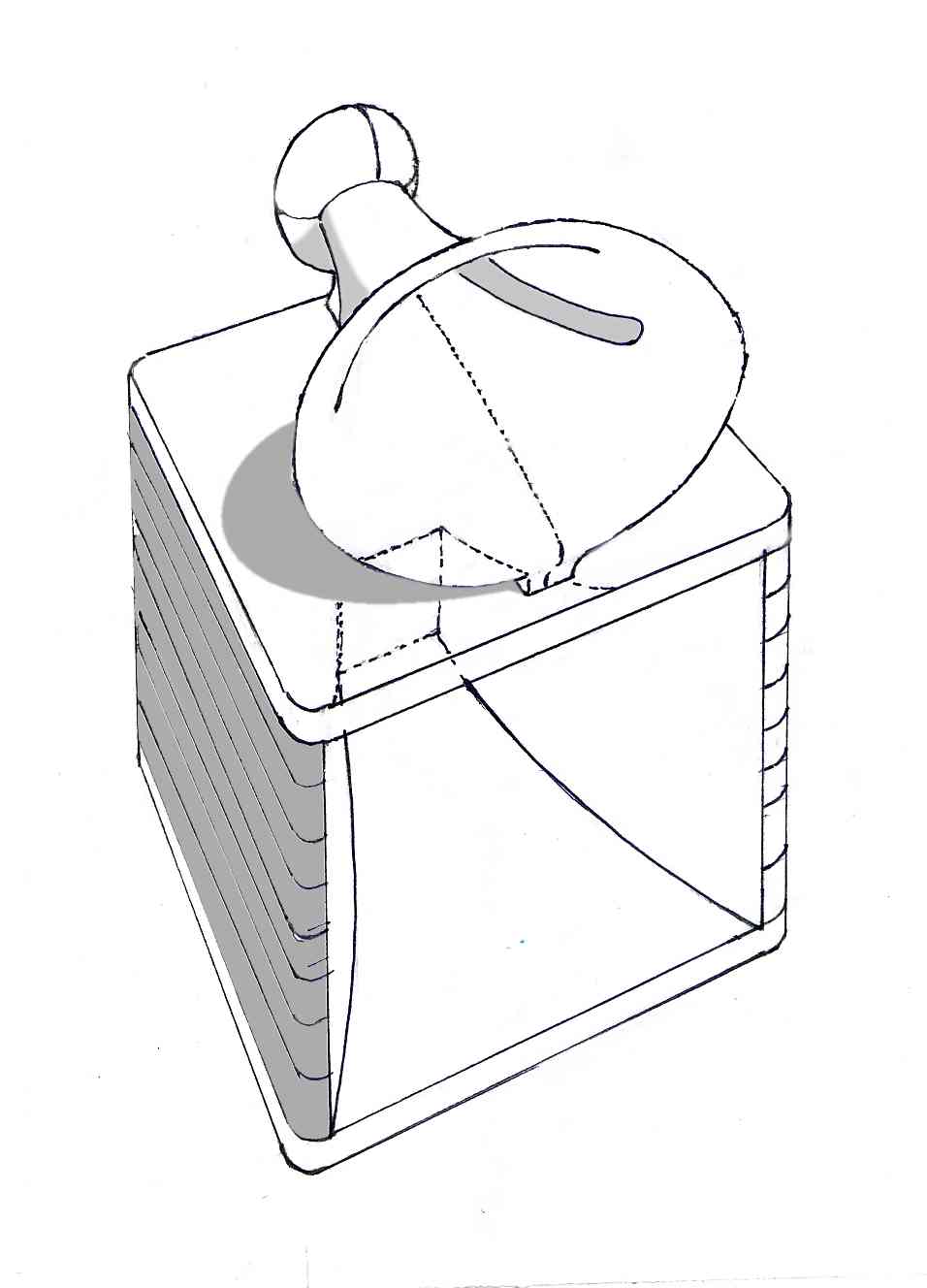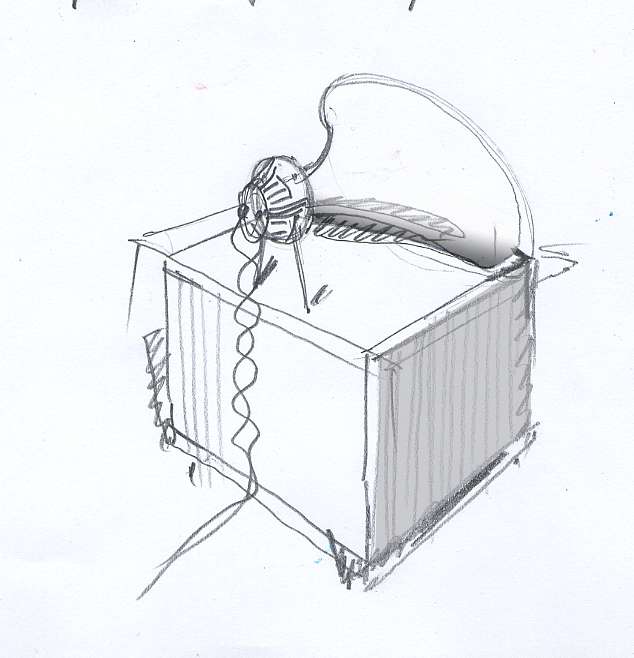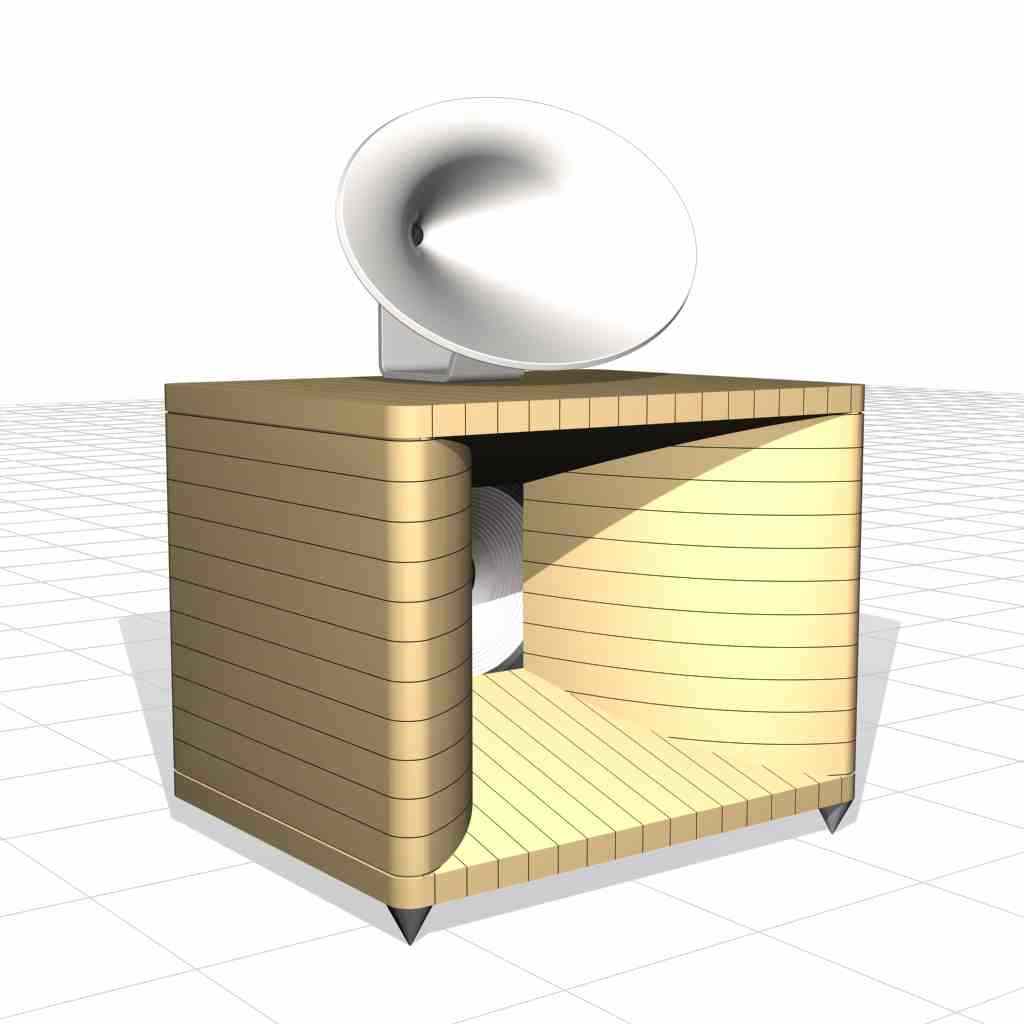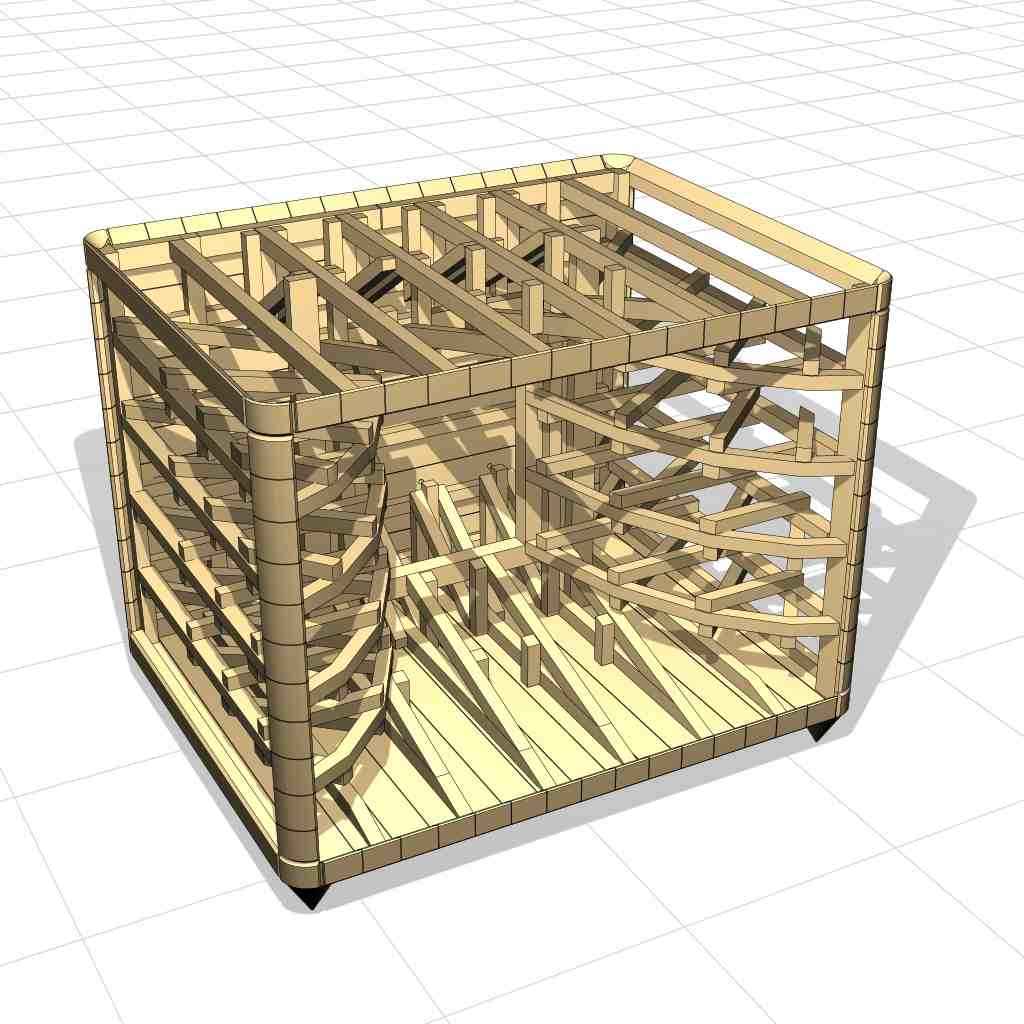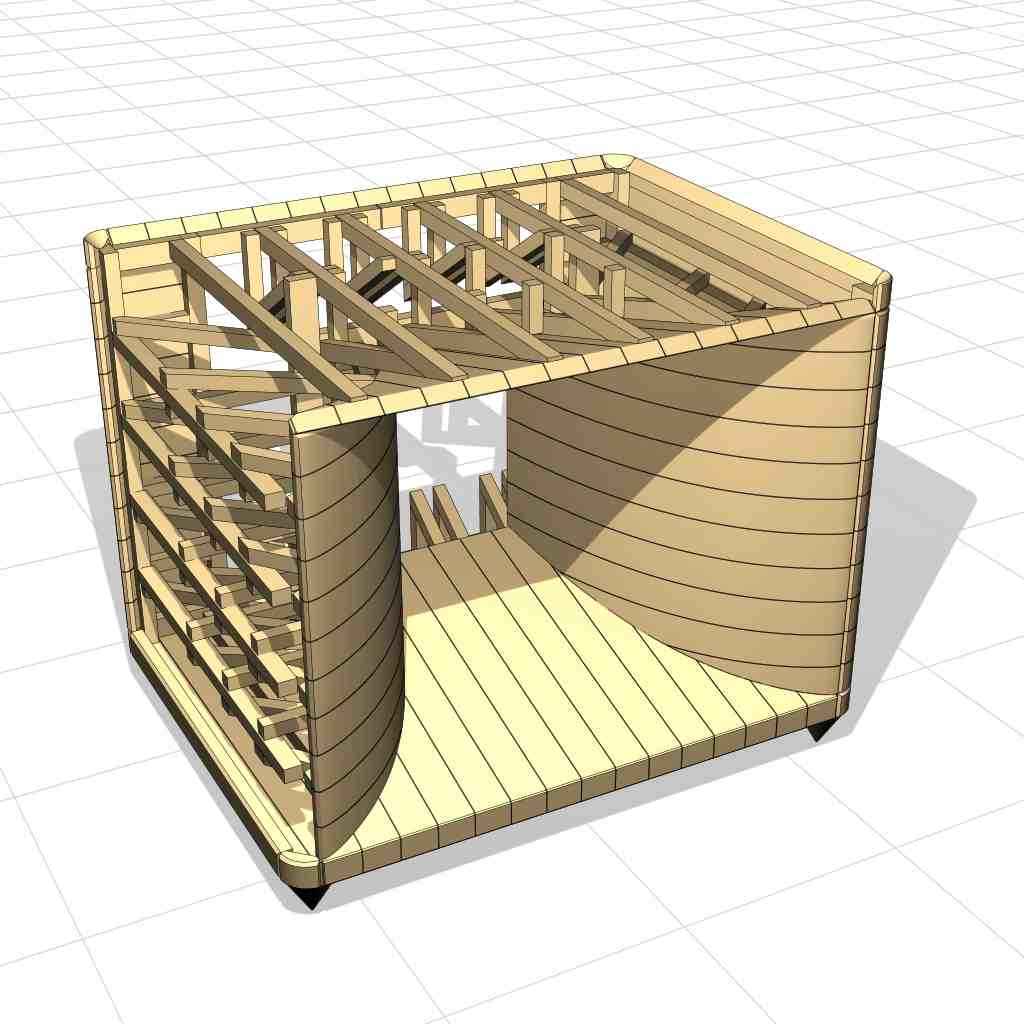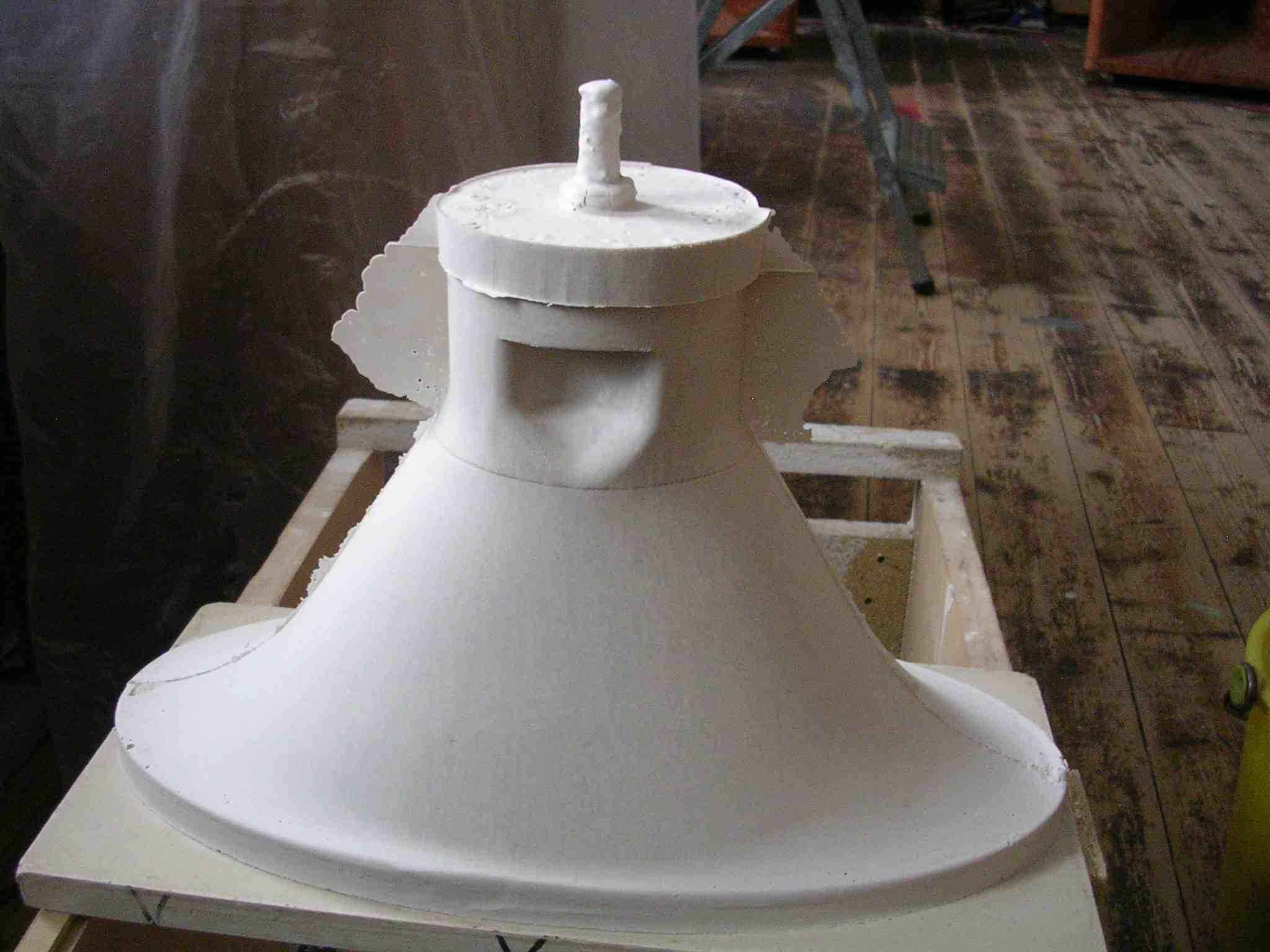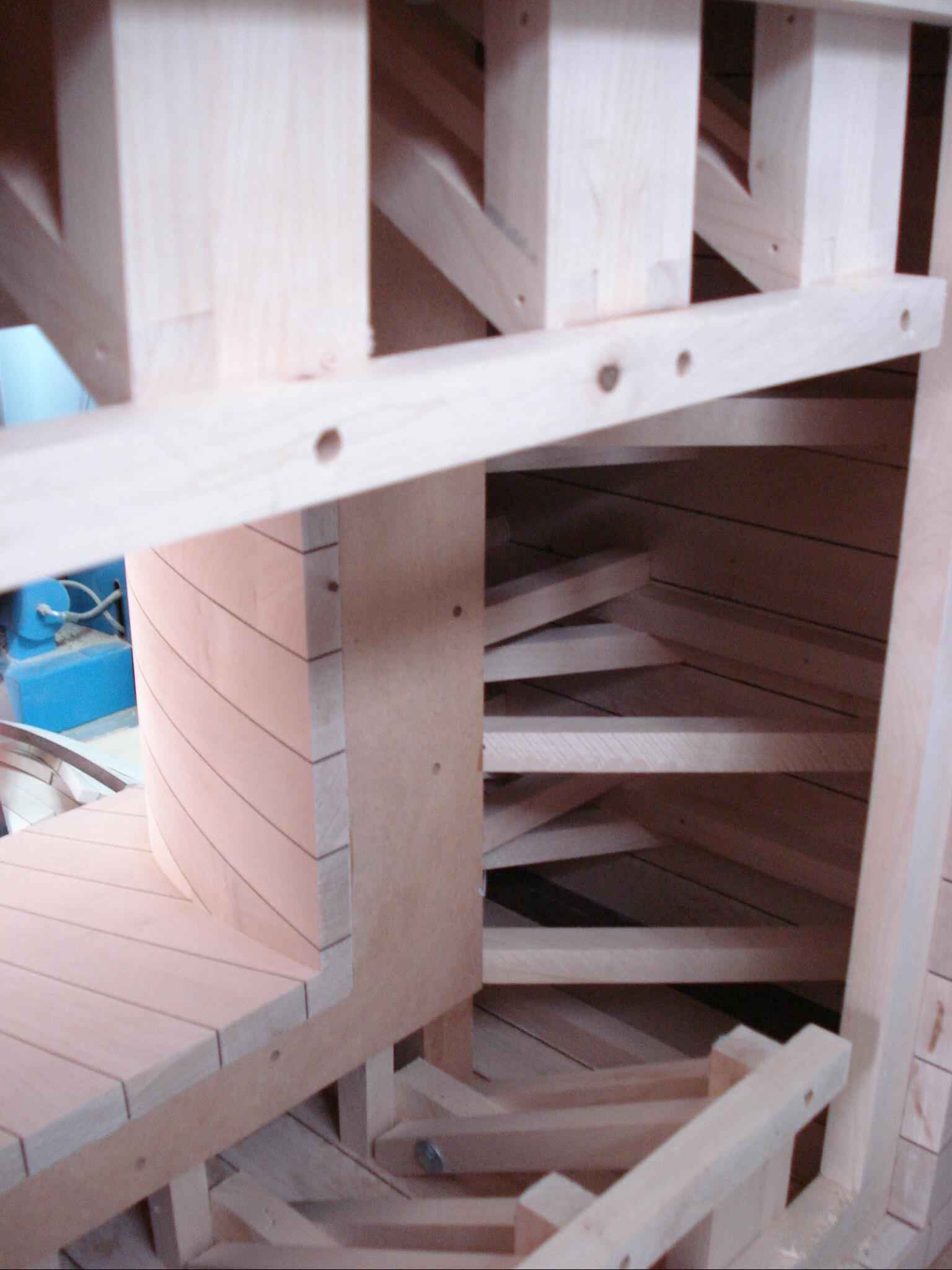

![]()
January 2012
- The
Haigner Gamma 3-Way Horn Loudspeakers
Personal
Listening Impressions
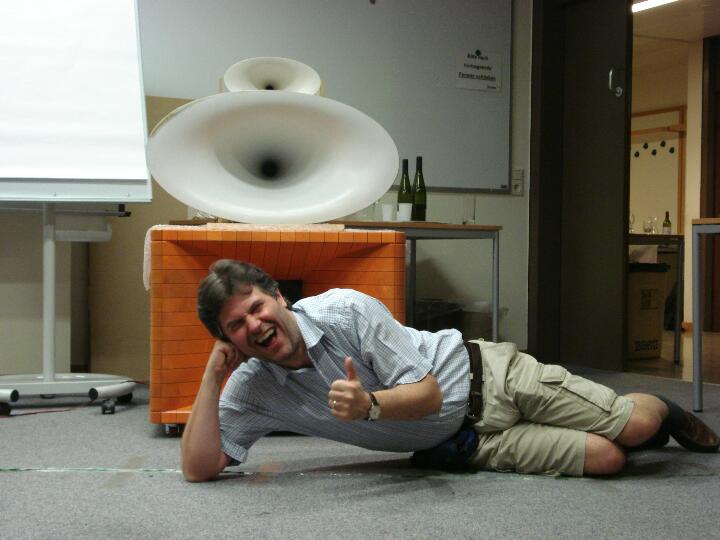
For
decades, there has been heated debate among audiophiles: What is the
most important part of an audio system in terms of being the most
influential on the sound of the system? Ivor Tiefenbrunn of Linn fame
has very successfully introduced the concept of the source being the
most important factor in an audio system. Others say that listening
pleasure is decided within the amplification stage. The third group
believes that the loudspeaker system at the end of the chain is the
most important factor in reproducing recorded music as good and real
as possible.
You might ask what I think about this topic...
Well, I have to confess that in some ways, all three opinions have their truth. In my younger years, I followed the Linn strategy as their principle of "what you lose at the front end, you can't win back later" seemed quite logical to me. As a consequence, I bought myself an LP12, Lingo, Ekos, K18 vinyl playback combination back in the late 80s. After I had recovered from a kind of "culture shock" due to the fact that I had spent a fortune (at that time roughly EUR 4,000) for just a TT, I enjoyed my LP12 combo for many years and still do.
When I heard a good SE triode tube amp for the first time, with its ability to reproduce music in wonderful tonal colors and shadings, I started to understand the opinion of the second group of audio nerds. My recent experience, listening to vinyl and CDs with a Kondo M7 tube preamp / Kondo Shinry 300B SE stereo amp combination driving the Haigner Tau speakers, dramatically underscored the importance of amplification stage quality. This was definitely an unforgettable experience; with regard to musicality and realistic reproduction of music, this is now my personal reference for the ultimate word in amplification.
Finally, my decision to order a pair of Haigner Gamma horns was influenced by how great the Haigner horn speakers work with low- to middle-class equipment. During years past, I was lucky enough to experience David Haigner's development work on horn speaker systems (Alpha and Beta horns) firsthand and was utterly surprised by the great musical results in some of the listening demos, although the rest of the equipment used was, for example, audio equipment in the lower price range, i.e. below EUR 1,500 for amplifier and CD player. The listening experiences were still stunning and more involving than anything I had heard before from conventional speakers driven with high-class electronic and source equipment. Of course, with better equipment connected to these horn ls-systems, you gained in musical pleasure and all other audio criteria, but what you got with lower priced front-ends made me rethink my opinion about audio equipment in general.
I now was convinced that my final loudspeaker had to be a Haigner horn speaker system. These audio lessons taught me that the loudspeaker, if it is designed properly, is the most important part in creating a wonderfully realistic and captivating audio experience in one's home. All of David's loudspeaker designs deliver these magical audio experiences, but, due to the advantages in resolution as well as the dynamic expression of a horn design in general, the improvements in musical performance are more than subtle with the Haigner horns.
So, when David informed me four years ago of his new project, the Gamma horns, which were intended to be a more compact version of the stunning Alphas (the latter have two 18" bass drivers: see my report here) I made the commitment and ordered the first pair. My plan to get a new car was dumped - I bought a 2 year old Subaru Impreza instead - and invested the difference in my dream speakers. I didn't know at that time, how wise this decision was, but one thing after the other...
The Gammas were planned as two-way horn speakers with a 15" bass driver in a wave guide supported bass enclosure and a medium-sized elliptical mid-treble horn section. As the first results were technically so promising, David decided to go for the ultimate version and design a 3-way horn-speaker system instead, with the midrange horn from the Alphas and a smaller, newly developed treble horn. For the bass, David and I agreed on a pair of vintage Altec 416-8A (8 ohm) drivers, I had bought some years before on Ebay. David normally works with new production drivers, but as his measurement revealed that my Altecs were great for the project, he was willing to use them. The midrange and treble drivers are BMS compression drivers, a German company David regards for their high-quality drivers. With the drivers chosen, David reached an efficiency of 99dB at 6.5 ohms impedance, so perfect for my love of SE amplification. Due to a a bass reflex port in the rear, carefully matched to the Altec 416 driver in the bass enclosure, the bass goes down to 28 Hz in my room (in-room measurements by David Haigner). Here are some photo impressions of different stages of the design process of the Gamma:
|
|
|
|
|
|
|
|
Raw cast blank of the newly developed treble horn |
|
Model of the mid-horn |
Rear
view into one bass enclosure of my Gammas |
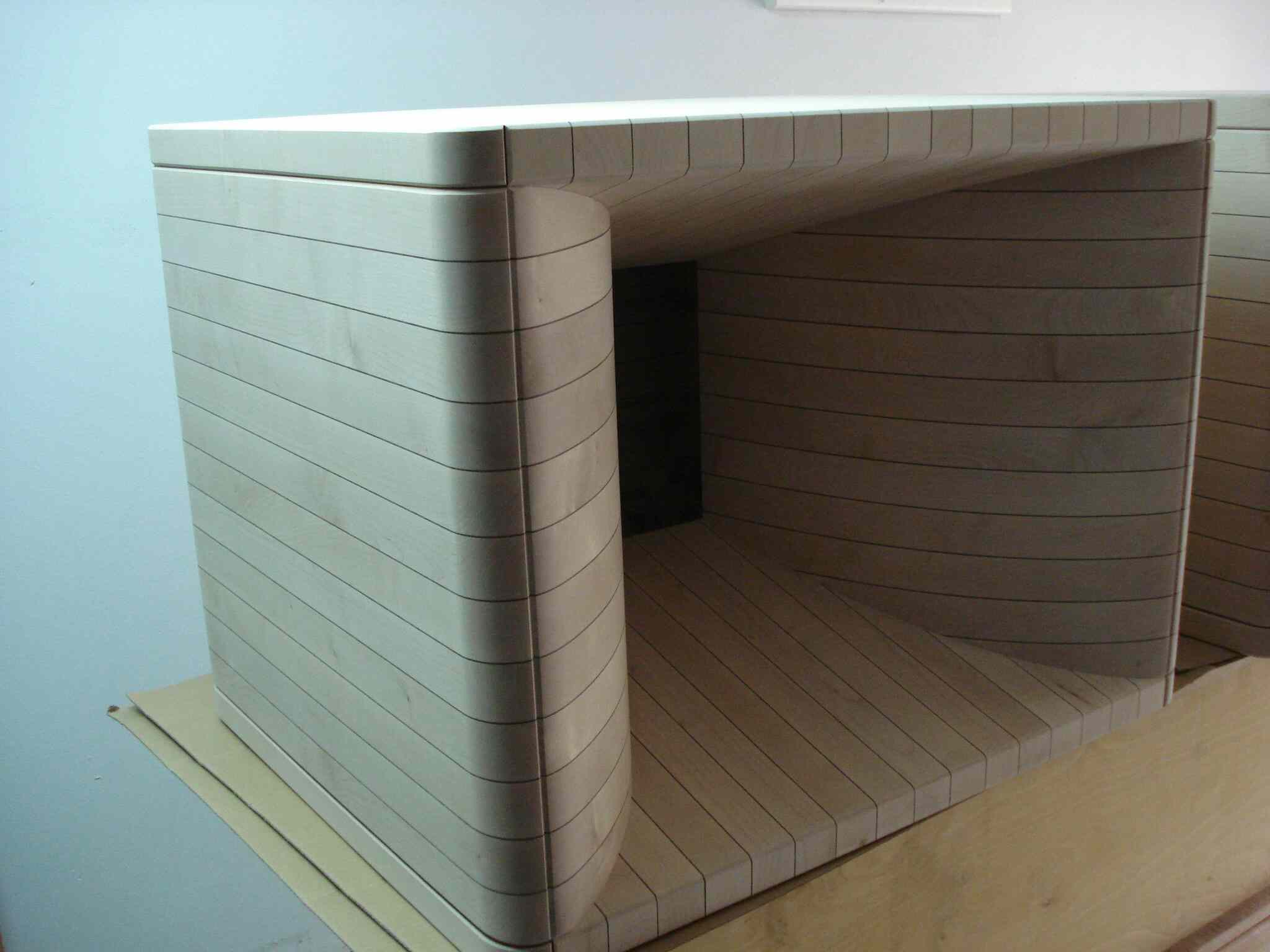
First meeting with the unvarnished bass enclosures made of solid maple. The cabinetmaker is a true artist, who used about 1.5 cubic meters of maple to finish these enclosures. The inlays are made with two layers of wenge veneer.
and
finally...
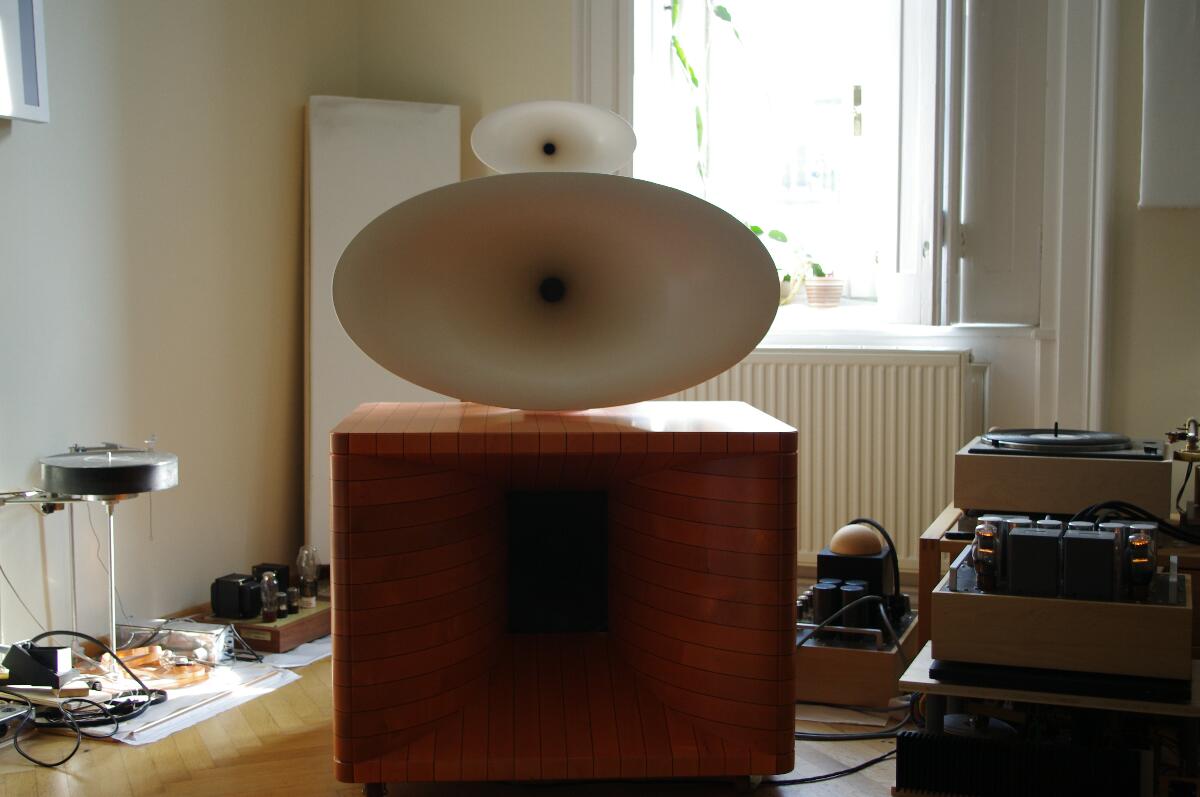
Gamma in my music room
There
are quite a number of audiophiles out there who don't like horn
loudspeakers due to their tendency of coloring the reproduced music
as well as the higher energy they confront the listener with; I know
what these people mean as I have listened to some vintage horn
loudspeakers before. Such concepts are big fun to listen to, but they
are not the truest in reproducing acoustic instruments. So, overall
there is the belief that a horn system, despite its big advantages in
speed and dynamics relative to a conventional passive loudspeaker
(about 5x the energy is released into the room) will always sound
colored, especially in the very critical midrange. To be more
specific, most likely at the cross-over points to the lower- and top-end.
But once you've heard a Haigner horn system for yourself, you will learn that this is only a myth. David Haigner's crossover techniques are so advanced that you will not be able to hear any coloration in his horn-ls designs. You will only hear wonderful tonal colors and an extremely realistic and holographic reproduction of acoustic instruments, for example. This is really stunning!
I'm
sure that most audiophiles, who have the usual experience with
vintage horn ls, would have shaken their heads in disbelief about my
ordering a pair of Haigner Gammas to listen to at about 2.5m distance
in a room of roughly 24 sqm. Even some of my audio friends thought I
was a bit crazy, since listening to your beloved records and CDs with
vintage horn ls at a listening distance of 2.5m in an only moderate
sized room is a kind of insane idea.;-) Well, I think, they all are
utterly wrong. After a year with the Gammas, I have to say it's pure
magic to listen to music through them in this nearfield situation.
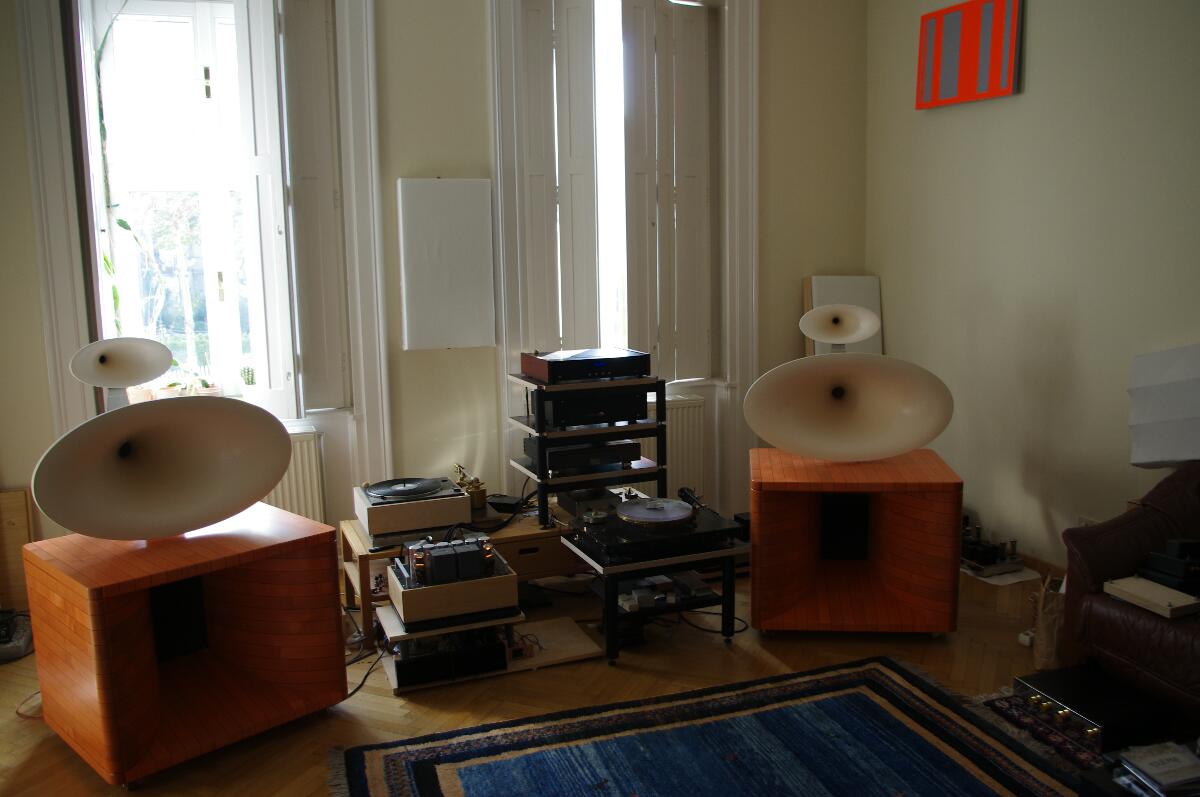
Photo
of my room with Gammas and system, while standing behind the listening-sofa
Of course, I know that had I a bigger room, let's say about 60 sqm, the Gammas would perform in a grander and more relaxed way. With the current set up, however, I like to get the feeling of having a solo blues musician or a jazz trio invited into my room due to the nearfield listening scenario. ;-)
***
Ok, now we come to the musical qualities of these extraordinary loudspeakers. Are they as promising as they look in reproducing music from our beloved LPs or CDs?
I wholeheartedly answer this question with an enthusiastic YES, YES, YES! They are f#*ng unbelievable in reproducing every kind of music you throw at them. They are extremely dynamic, fast and lively, which is why so many audiophiles love horns, but they also reproduce the tonal colors of acoustic instruments with such lifelike realism, that I'm amazed every time and in awe of the performance of the Gammas. David Haigner is a master of cross-over design and his speakers are, in my opinion, so much different and so technically ahead of what the rest of the industry has to offer, because he produces speakers which are fully time and phase coherent. In addition, his horn systems are completely free of coloration over the whole frequency spectrum as well as an easy load impedance-wise, which is a miracle in my book.
You want an example? Ok, here you are: Let's take a piano for example. A piano is not only one of the most difficult instruments to record realistically, but also it's (in my opinion) by far the most difficult instrument to reproduce for any hi fi system. Listening, for example, to the 1979 live recording of Beethoven's Piano Concerto No. 1 performed by the magnificent Arturo Benedetti Michelangeli and the Vienna Symphony Orchestra (DG 2531 302, LP) in Vienna, you hear a piano which is reproduced extremely realistically and believably from top to bottom. The bottom register's energy and the interplay with the orchestra are especially breathtaking. The recording is definitely not the best in overall terms, DG pressings of the 70s to mid 80s are not regarded as the pinnacle of what a record can deliver, but listening to this one over the Gammas is truly wonderful, lively and engaging from the beginning to the end.
In general, I would say that the Gammas should be a must for professional recording studios to monitor their productions. Recording engineers and artists alike will appreciate them, as the former would have a definite control tool for their recordings and the latter would be able to hear themselves in a quality they have never encountered before. This would also be great for the buying customers, as crappy recordings and too much compression would be ruthlessly revealed. I would love that; I'm sure you too ;-)
Let's go on with musical examples. Stanley Turrentine's "Smile, Stacey" from the "That's where it's at" LP (BlueNote BST 84096 with Les McCann, Herbie Lewis and Ottis Finch, 86s Teldec reissue), grooves like mad. Man, I can't get my feet under control&ldots; they want to dance :-).
Another example is an African song called "Kothbiro" performed by the Kenyan song writer Ayub Ogada (Track 11 of the Putumayo World Music compilation on CD "Music from the Coffee Lands", PUTU 135-2). The magical and haunting voice of Mr. Ogada is mesmerizing, the background instruments and voices blend in wonderfully, and in closing the eyes, one is transformed to the Savannahs in Africa. That's what music is all about, in my opinion.
Back to LP as my Lenco is better than ever, since I've got myself a fantastic phonostage, the LFD MCT SE, the best transistor phonostage I've ever heard. This gem is hand-built in the UK by Dr. Richard Bews, mastermind behind LFD Audio, who has built up a lot of fame among music lovers for designing extremely musical audio equipment. He was a student of Prof. Malcolm Hawksford of the famous University of Essex and is one of the true masters of tweaking equipment to the maximum musical pleasure by focusing on the quality of the power supply as well as using high quality vintage parts and his own superb cable designs at sound critical places in the design. (More info on the LFD MCT SE will come in a separate article soon).
Putting the new LP "Ashes & Fire" of Ryan Adams on my Lenco's platter, reveals another gem of superb song writing, off the beaten track of what radio stations normally play. That's sad but true! This late 2011 production gets my vote for the best pop album of 2012! Especially, the slower songs, the whole side 2 for example, nurture my soul. This isn't a high-end production in the demo sense, although very well recorded, so no show-piece to impress people, with kick drums or extremely detailed articulation sounds of the lead voice. With the Gammas, however, the music envelopes you, and Mr. Adams transports emotions and enchants you with his songs about love, kindness and lost love. His performance is top-notch. For me, his best album by now.
Back
to the Haigner Gammas! Another big advantage of these fantastic
loudspeakers is that they always honor improvements in your audio
equipment or the room itself with gains in sound and musical
pleasure. They are like a magnifying glass, so it's a lot easier to
compare equipment and hear the differences in cables, for example. As
I wanted to get my sound as good as possible for my audio budget, I
was inspired to experiment with the placement of my equipment and the
racks I use and to make improvements in my room treatment. It was
worth it, as the Gammas "told" me the truth every time, be
it an improvement or a step in the wrong direction.
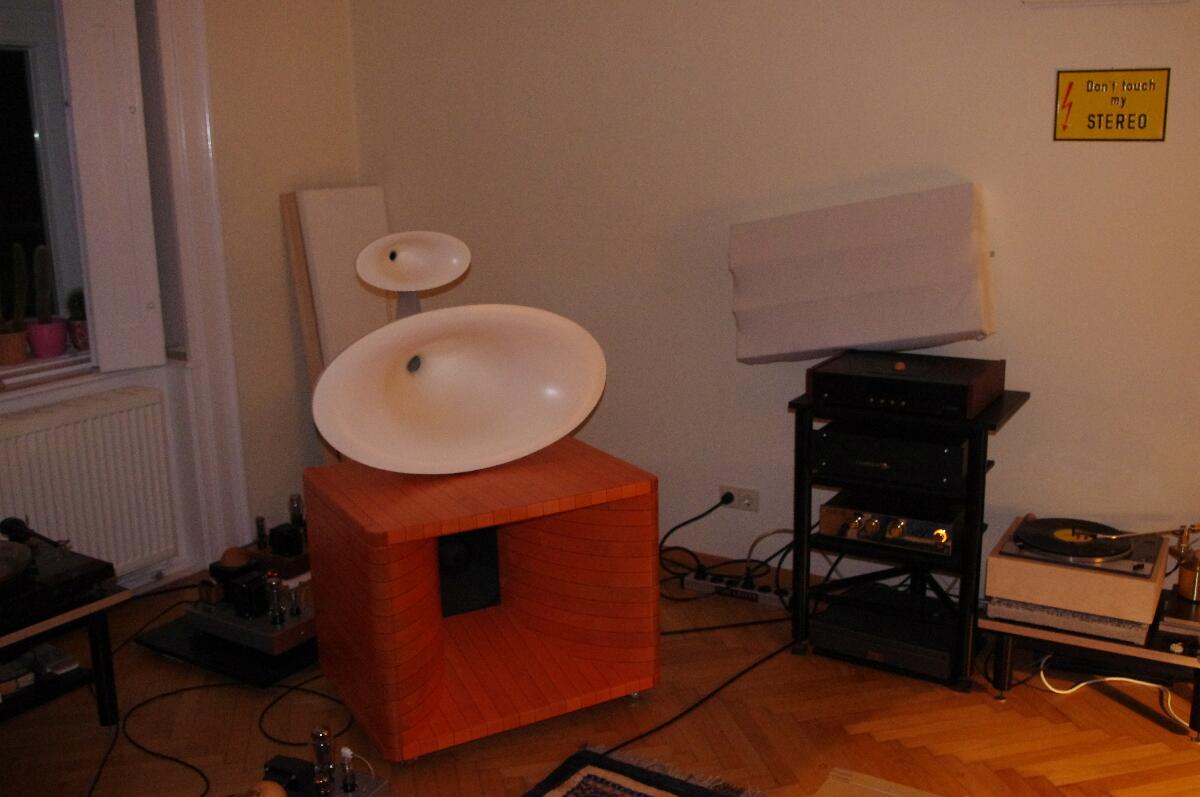
Music
room after I finished
experimenting
with the placement of preamp, Phono- and CD front-end
Another strength is their flexibility with the amplification used. When my friend Alexander, the Jazz connoiseur in our Vienna audio circle, heard the Gammas the first time he was so impressed, that a week later he ordered a pair for himself. Important to mention, Alexander is a fan of top-notch "sand" amps as he sometimes likes to listen really, really loud, but without the soft-clipping effects of our beloved SE tube amps. So, David built his Gamma version using the same BMS mid and treble drivers, but with the 15" TAD TL 1601B he chose less sensitive bass drivers. So, efficiency in this case is about 97dB and the result is exactly what Alexander had in mind. The two approaches are so different in how music is enjoyed, but the Gammas excel in both cases.
Finally, as I wrote in my report about the Haigner Tau speakers some months ago, it's "the naturalness and ease of musical reproduction, especially the rendering of acoustic instruments," which strikes me most. With the Gammas, it's basically the same, although in a further improved version and with improved speed and dynamics as well as an increase in sound stage and presentation. I would say that with the Gammas, one comes mighty close to the ideal, i.e. the reproduction of a real instrument in one's listening room. And that is a statement I believe in! Yes, the Gammas are that good :-)
If you love music, please do yourself a favor and visit Mr. Haigner in Vienna for a demo of his horn loudspeakers. The new Gammas are fantastic speakers and are the best loudspeakers I've ever had the chance to listen to. Period! Enthusiastically and wholeheartedly recommended.
Musically
yours,
Norbert
Update
- March 2012:
Regarding the February comment below, please keep in mind that mine were the first pair of Gammas that David Haigner made, and so they benefited from his subsequent fine tuning in order to meet my preferred musical tastes.
As might be expected, however, the more recent Gammas that David has produced reach a plug-and-play solution.
Bottom
line:
the Gammas are
flexible enough to cater to a wide variety of demands, enabling you
to get your
preferred listening experience 'just right' - with or without
additional fine-tuning.
Additional
remark - February 2012:
To achieve the current quality of the Gammas, one has to know that it took David Haigner all of his expertise and untold hours in the last years. Further, adapting the Gammas to my music room and personal listening preferences took additional hours of fine tuning as well as feedback from my side.
With a system like the Gammas - as I said above, they are like a magnifying glass in reproducing one's favorite music - you can easily hear, for example, not only differences in amplifier topologies connected but also the smallest changes in the crossover network. This is especially true when one sits at such a close distance to the speakers as I do.
So, a change in the frequency range of 0.25 dB and smaller can make a big difference. I'm not kidding you; I have now more than a year of listening experience with the Gammas and believe me, I have learned a lot from these experiences and from David's meticulous professionalism. Hence, excellent part quality in the crossover is a must and is therefore the standard for the Gammas - that means for example Mundorf Silver/Gold capacitors are used in the mids and tweeter sections of the crossover as they optimally complement the BMS drivers. As a result, the outcome of David's hard work and passion is a statement loudspeaker, which is handmade with love and dedication in good old Europe!
©The
Audio Eagle 2005-2015•
All Rights Reserved • Disclaimer










